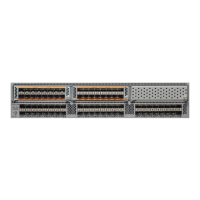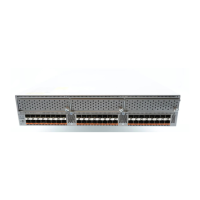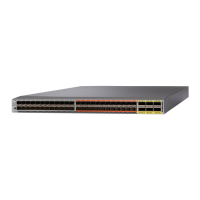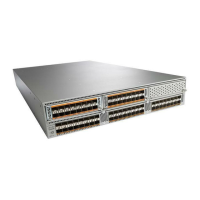Send feedback to nx5000-docfeedback@cisco.com
1-4
Cisco Nexus 5000 Series Switch CLI Software Configuration Guide
OL-16597-01
Chapter 1 Configuring Fibre Channel Routing Services and Protocols
FSPF Global Configuration
About Link State Records
Each time a new switch enters the fabric, a link state record (LSR) is sent to the neighboring switches,
and then flooded throughout the fabric.
Table 1-1 displays the default settings for switch responses.
The LSR minimum arrival time is the period between receiving LSR updates on this VSAN. Any LSR
updates that arrive before the LSR minimum arrival time are discarded.
The LSR minimum interval time is the frequency at which this switch sends LSR updates on a VSAN.
Configuring FSPF on a VSAN
To configure an FSPF feature for the entire VSAN, perform this task:
Table 1-1 LSR Default Settings
LSR Option Default Description
Acknowledgment
interval (RxmtInterval)
5 seconds The time a switch waits for an acknowledgment from the LSR
before retransmission.
Refresh time
(LSRefreshTime)
30 minutes The time a switch waits before sending an LSR refresh
transmission.
Maximum age (MaxAge) 60 minutes The time a switch waits before dropping the LSR from the
database.
Command Purpose
Step 1
switch# configuration terminal
switch(config)#
Enters configuration mode.
Step 2
switch(config)# fspf config vsan vsan-id
Enters FSPF global configuration mode for the
specified VSAN.
Step 3
switch-config-(fspf-config)# spf static
Forces static SPF computation for the dynamic
(default) incremental VSAN.
Step 4
switch-config-(fspf-config)# spf hold-time
value
Configures the hold time between two route
computations in milliseconds (msec) for the
entire VSAN. The default value is 0.
Note If the specified time is shorter, the
routing is faster. However, the processor
consumption increases accordingly.
Step 5
switch-config-(fspf-config)# region region-id
Configures the autonomous region for this
VSAN and specifies the region ID.

